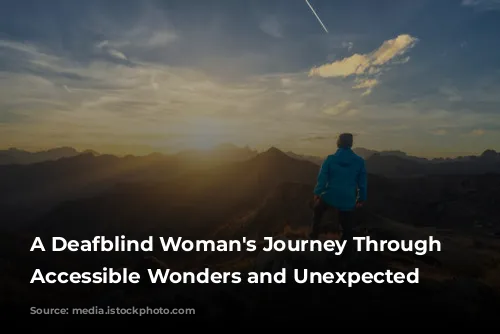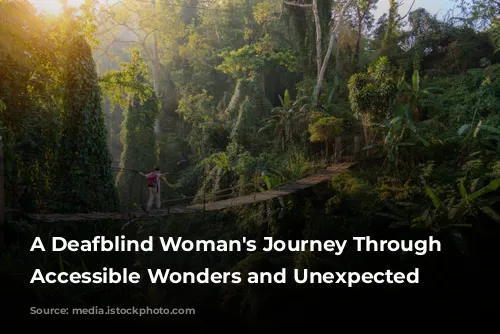My two-and-a-half weeks exploring Japan as a woman with both vision and hearing impairments left me utterly astounded. My travels through Tokyo, the sprawling metropolis, and Sapporo, the bustling heart of Hokkaido, offered a captivating glimpse into how different cultures cater to individuals with disabilities.

Japan’s Accessibility: A Step Above the Rest
Japan was the grand finale of my four-month global adventure. Among the 15 countries I visited, Japan’s infrastructure emerged as the most accessible, surpassing even my own country, the United States.
Yellow tactile strips were a common sight, acting as guiding lines in virtually every major public space, from bustling subway stations to sidewalks in Tokyo and even some indoor shopping malls. These strips served a dual purpose: they ensured everyone stayed on the left side, a standard in Japan, while navigating crowded spaces, and led visitors to essential locations like ticket booths and exits. While they might not be helpful for tourists unsure of their destination, they proved invaluable for those familiar with their surroundings. Additionally, tactile bumps preceded many stairwells and escalators, a welcomed sight in a city with an extensive network of public transportation.
I found these features incredibly helpful, and I couldn’t help but question why my own country rarely implemented such straightforward solutions. They’re easy to install, unobtrusive, and beneficial for everyone, not just those with visual impairments.

Navigating Tokyo’s Labyrinth: An Exercise in Patience
While these accessible features were a positive step, they couldn’t fully compensate for the disorienting nature of older Japanese cities like Tokyo. The lack of a grid system in both the streets and subway stations meant navigating as a tourist was a constant test of patience. The intricate Tokyo subway stations, with their limited English signage and numerous entrances and exits, proved challenging for any foreign visitor. Rush hour added another layer of difficulty, making space a precious commodity. Despite the general politeness of the Japanese people, their willingness to make room for others couldn’t always overcome the sheer volume of people. The absence of safety barriers between the platform and the tracks posed a significant safety concern, particularly for the visually impaired, demanding extra caution during peak hours. Despite the presence of tactile strips, such places could be disorienting and even baffling. (A friendly reminder to travelers: you can seek assistance at any station, but English proficiency might be limited.)

Sapporo’s Serenity: A Breath of Fresh Air
I discovered a much calmer and more navigable environment in Sapporo, one of the few Japanese cities with a grid system. Its subway system, newer and more spacious than Tokyo’s, provided a smoother and more accessible ride. My visit during the winter months brought inevitable snow and ice, although I’ve heard Hokkaido is a true gem during the summer months.

Small Touches with Big Impact: Braille on Beer Cans
Throughout my trip, I encountered other small but thoughtful accessibility features. One such example was braille on beer cans. Typically, it simply indicated “alcohol,” but sometimes it spelled out the manufacturer’s name. Sadly, this was of limited use to me as I’m not familiar with Japanese braille.

Genkan Encounters: A Cane’s Dilemma
Another challenge I faced, or rather, my white cane did, was the genkan, the entryway that separates the outdoors from the indoors, where shoes are traditionally removed before entering a home. This custom is designed to keep outdoor dirt and grime from contaminating the interior. My white cane, which always has its tip on the ground, inevitably accumulates dirt, but it’s also my essential guide through unfamiliar environments. This presented a dilemma. When wipes were available, I would do my best to clean the tip. When they weren’t, I navigated the indoor spaces independently, which was relatively easy as Japanese homes are usually sparsely furnished and simply laid out. Next time, I’ll be sure to pack my own wipes!

Japan’s Accessibility: A Journey of Inspiration
My visit to Japan was a wonderful encounter with a vibrant new culture and friendly people. The built-in accessibility features enriched an already amazing experience.
I’m chronicling my four-month journey around the world as a deafblind woman. If you’re interested, please check out:
• Why a Deafblind Woman Decided to Travel the World
• How Visiting Auschwitz Taught Me How to Sightsee Without Sight or Hearing
Have you had the opportunity to explore Japan? Do you have a disability? We’d love to hear your story! Sharing your experiences not only provides valuable insights but also encourages other individuals with disabilities to embark on their own journeys to Japan. Get in touch if you’d like to share!









